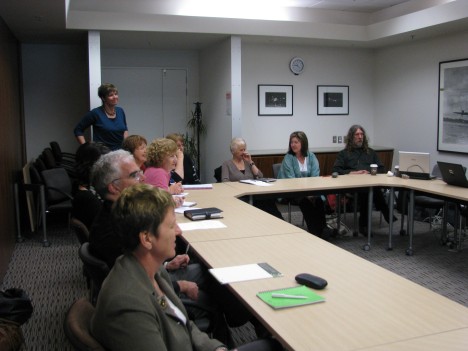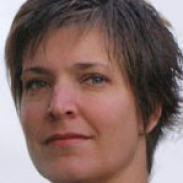ATKINS ADVICE TO POLYTECHS/UNIVERSITIES
Collaboration is key to making
virtual education work in NZ
Nurse educators ‘convinced’ of value –
the question is, how best to use it.
 NZ nurse educators at the Wellington SLENZ meeting.
NZ nurse educators at the Wellington SLENZ meeting.
Collaboration between tertiary educational institutions in the implementation of virtual world education scenarios is the key to making them economic, effective and successful in a country as small as New Zealand.
This is the view of of the joint leader of the SLENZ Project, Dr Clare Atkins, who has worked for 16 months on three education pilot education projects funded by the Tertiary Education Commission of New Zealand to determine the benefits or otherwise of education in virtual worlds and how the benefits, if any, can be harnessed successfully by New Zealand educators.
Dr Atkins expressed her view at a meeting attended by eight leading nurse educators from a number of polytechs in Wellington last week.
“It makes sense to collaborate,” Atkins said. “It would be crazy to try to do things separately when you can share and collaborate.”
She suggested that New Zealand’s Polytechs and/or Universities could band together inexpensively to increase New Zealand’s educational usage of and presence in Second Life, around the virtual island “archipelago” already created by the Nelson-Marlborough Insitute of Technology (NMIT), the SLENZ Project, and The University of Auckland. Virtual land for education could be made available economically within this hub area, she said.
Atkins noted that whereas a Second Life build from scratch, such as that of the SLENZ Project’s midwifery pilot could cost up to NZ$30,000, collaboration by institutions both in New Zealand and overseas – and the sharing of already created facilities – could reduce on-ground, virtual world costs for individual collaborating institutions to several hundred dollars a year, if enough were involved.
“There is no point to reinventing the wheel,” she said. “Second Life is notable for the way educators share and collaborate.”
The one-day meeting, sponsored by the SLENZ Project followed expressions of interest from nurse educators who had viewed or attended presentations on the SLENZ Project’s Midwifery and Foundation Learning pilot programmes. The nurse educators attending represented among others, UCOL, Manukau Institute of Technology, NMIT and Whitireia Community Polytechnic. The national co-ordinator of nursing education in the tertiary sector, Kathryn Holloway, also attended.
Besides Atkins, the meeting also included presenations by other SLENZ Project members, and a Second Life nursing training presentation by Second Life’s Gladys Wybrow, of The University of Auckland.
The meeting, less than a week later, has led to the establishment of a “collaborative” New Zealand Polytech nurse educator project to explore and develop the potential of Second Life in Nurse Education.
The project, Nurse Education in Second Life NZ, based on a ning created by Jean Jacoby (pictured), an instructional designer, at the UCOL School of Nursing Palmerston North, already has 20 members.
Jacoby, who has taken on a co-ordinating role, said in a dispatch after the meeting, “It seemed to me that none of us needs to be convinced of the value of exploring Second Life; rather we are looking for practical ways to do so.
Two main approaches
“There seemed to be two main approaches identified at the meeting,” she added. “Looking for existing builds that we can adapt or use as they are” and/or “Identifying a small, practical project to build from scratch, for which we could potentially get funding.”
The nursing group is currently in the early stages of discussing a proposal to set up a verbal health assessment scenario, with the nurse getting the information from the patient.
According to Susie le Page, also of UCOL, this suggested Second Life application could be applied across a number of nursing areas, including midwifery, mental health and the medical/ surgical community.
Meanwhile commenting on the meeting the SLENZ Project’s lead educator for Otago Polytech’s Midwifery pilot on Kowhai in Second Life, Sarah Stewart (SL: Petal Stransky) offered advice, based on her Second Life experience, to the nurse educators.
Stewart said nurse educators contemplating using Second Life should: find a Second Life mentor and learn as much as you can about how Second Life works; network with other nurse and health professionals using SL using online communication tools such as blogs, YouTube, Slideshare and of course, Second Life; develop learning activities in Second Life that require little or no development to keep things as inexpensive and easy as possible; work alongside your educational institution to ensure you have full access to Second Life; collaborate with each other using virtual tools such as wiki, Google Docs, Skype and Second Life.
At the same time as the nurse educator meeting SLENZ Project joint leader Terry Neal (SL: Tere Tinkel) and Foundation Learning pilot lead educator, MIT’s Merle Lemon (SL: Briarmelle Quintessa) briefed representatives of the Open Polytechnic, UCOL, CPIT and Wairakei Polytech at another venue, delivering a similar message to that of Atkins.
EVENT -Kiwi educators
Sunday 8 November 7 pm (NZ Time) – meet on Koru shortly before 7pm: This week Kiwi Educators have been invited to tour the University of Western Australia sim. Our guide will be Jayjay Zifanwe, owner of the UWA sim. Highlights of the tour will be the main landing area, Sunken Gardens, Sky Theatre, Square Kilometer Array, Visualisation Research & the 3D Art & Design Challenge. This amazing SL campus is a pefect combination of realism and fantasy and well worth a visit. – Briarmelle Quintessa.
Filed under: Education, Education in Second Life, Education in virtual worlds, Second Life, SL Medicine, SLENZ Project, Virtual Worlds | Tagged: Dr Clare Atkins, Gladys Wybrow, googledocs, Jean Jacoby, Kathryn Holloway, Manukau Institute of Technology, Merle Lemon, NMIT, Nurse education, Nurse Education in Second Life NZ, Otago Polytechnic, Sarah Stewart, Second Life, SLENZ Project, Slideshare, Susie le Page, Terry Neal, Tertiary Education Commission, The University of Auckland, UCOL, University of Western Australia, Virtual World collaboration, Warakei Polytechnic, Whitirea Community Polytechnic, YouTube | 6 Comments »


